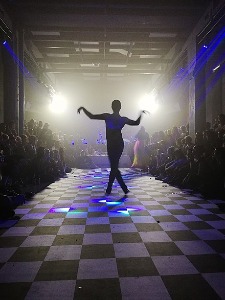
The 1990 documentary
Paris Is Burning
is not about a fire in Paris at all. Rather, it is about the passion that set aflame Harlem’s diverse youth in a search for identity and belonging. The film portrays the struggles of LGBTQ people of color in the 1980s and the establishment of ballroom culture, a phenomenon that began long before the '80s and one that has now become more mainstream. From the jarring realities of race and gender to voguing and legendary houses, ballroom was the American Dream reborn for Black and Latino youth.
Ballroom culture, also known as ball or house culture, began in the late 1860s when The Hamilton Lodge No. 710, a Black club in Harlem, started to hold the Annual Odd Fellows Ball. The gala was home to drag queens and kings who competed for prizes. It boasted attendance from spectators of all races, genders, and sexualities nationwide, once holding 8,000 visitors for their 1936 ball. Despite the Lodge’s efforts to diversify ball attendants, however, race and class divisions were soon apparent. Straight-passing middle-class men, along with the “intelligentsia and social leaders” of Harlem, would watch working-class men in drag perform.
Other historically normalized forms of discrimination were emphasized much later in the 1960s by Black drag queen Crystal LaBeija. In an infamous scene at the American Camp Beauty Contest, captured by Frank Simon’s 1968 documentary,
The Queen
, LaBeija calls out fellow drag queen and contest emcee Flawless Sabrina for rigging the contest in favor of another White queen. This illustrated how Black queens were expected to look White in order to have a chance at the title.
Experiences like those previously mentioned prompted LaBeija to put on the first ball for the Black LGBTQ community in 1962. Later, in the early ’70s, LaBeija pioneered the creation of houses, with the House of LaBeija being the first. The idea behind these houses is the ability to build and choose your own family. This was something that many young LGBTQ people of color lacked since many were homeless on the streets of New York City. A house mother or father, such as LaBeija, provided shelter, food, and a sense of belonging for these kids, along with a chance to compete in balls.
As other houses sprouted into the scene, they took to the ballroom floors in competition. In 1981, balls were split into multitudes of categories. These categories included “butch realness,” “models effect,” and “face,” which evolved throughout the ’80s into ones like “executive,” “town and country,” and “ethnic.” Participants would dress accordingly to compete in each category. Many categories were tagged with the word “realness,” that measured one’s ability to fit into the cisgender and heteronormative world they were rejected from.
Another method of battling between houses was voguing, perhaps the most culturally recognized component of ballroom. The first movement took form in the ’60s. Known as the Old Way, the dance began by incorporating poses from models in the fashion magazine Vogue, where its name came from. During the ’80s, Willi Ninja, Mother of the House of Ninja and Grandfather of Vogue, led his house in spearheading the New Way on the ballroom floor. New Way voguing was highly inspired by Egyptian art and martial arts, playing into more dynamic, acrobatic, and athletic elements. Finally, in the ’90s came Vogue Fem, which used hyper-feminine gestures in performance.
In its height, voguing took ballroom from the underground to the mainstream. Voguing became the subject of songs like 1989 “Deep in Vogue” by Malcolm McClaren, which featured Willi Ninja in the song and music video. It also produced Madonna’s “Vogue” in 1990, which she found out about by watching two dancers from the House of Xtravanganza. Just a year after the song’s release,
Paris Is Burning
by Jennie Livingston burst onto the scene and took the Grand Jury Prize at the Sundance Film Festival, bringing ballroom to a much wider audience.
Not only did the film give its audiences a look into the otherwise fabulous world of ballroom, but it also portrayed the rather dark reality of sexual violence and the AIDS epidemic that hit LGBTQ communities of color with devastating effects. Several of those featured in the film passed away in the midst of the AIDS crisis, including Venus Xtravanganza, a young trans woman who was murdered.
Out of these tragedies came the birth of groups like the National Center for Transgender Equality, GLAAD, and the Human Rights Campaign, which continue to advocate for an end to the murders of trans women of color, workforce discrimination, inadequate healthcare, incarceration, and other issues affecting LGBTQ people of color. To this day, the Latex Ball, which began in 1990, is focusing on providing the community with health information and preventing AIDS/HIV in LGBTQ.
The ongoing FX series
Pose
, which was created by Ryan Murphy and written and directed by trans activist Janet Mock, serves a legacy of ballroom culture, bringing the stories and the art of the '80s to a new generation. The award-winning show features the largest cast of trans actors in television history with a cast and crew made up of over 140 LGBTQ people. The show has accumulated a cult following and has recently been renewed for a third season.
Ballroom has always been something for everyone to enjoy from its grand beginnings in Harlem clubs. It is a world that has withstood division only to find a family—a community—waiting for them at the end. As ballrooms worldwide teem with excitement for the next queen to walk, the pioneers of ballroom will take their righteous place in LGBTQ history.
[Source:
Rolling Stone
]

